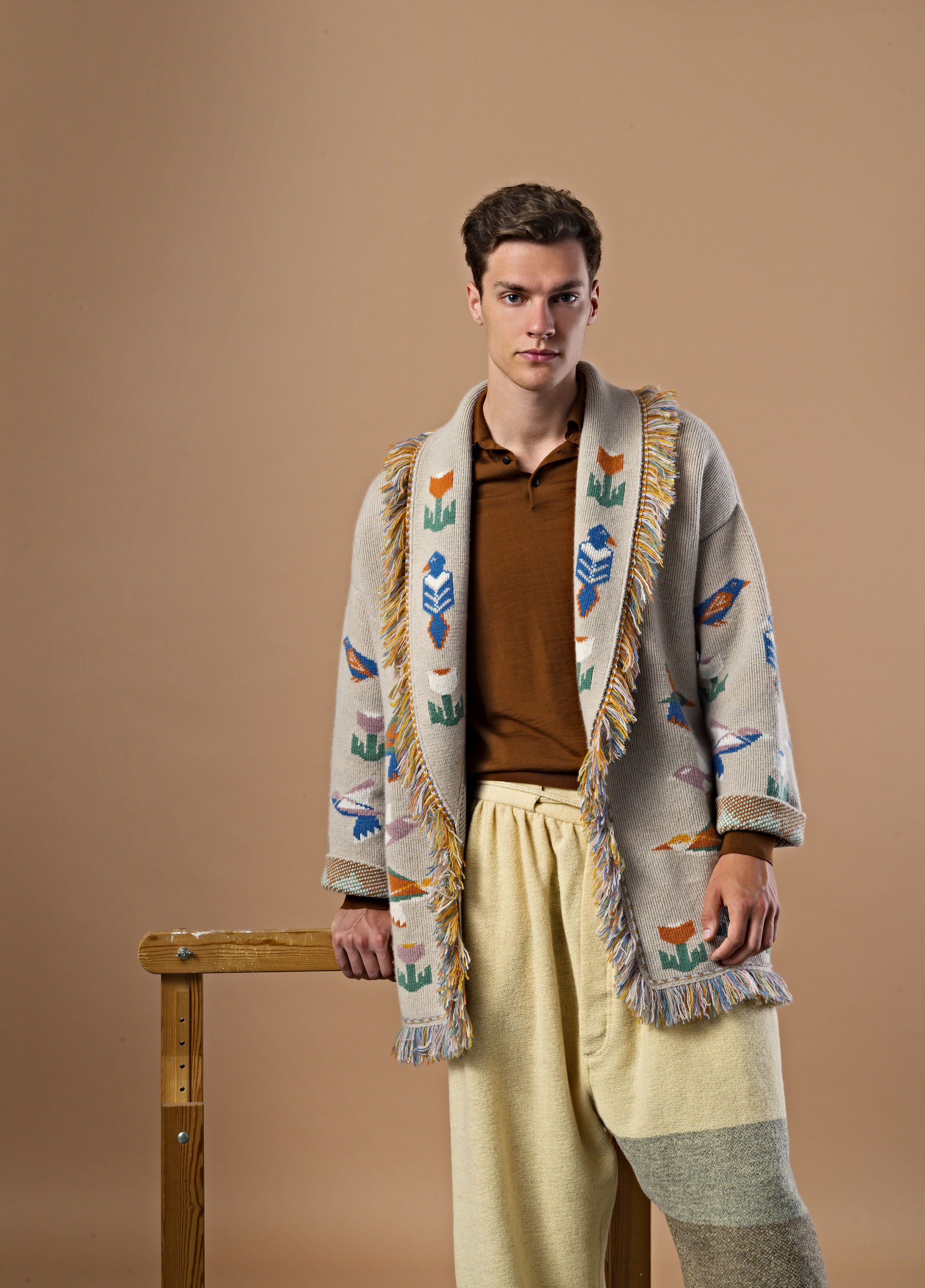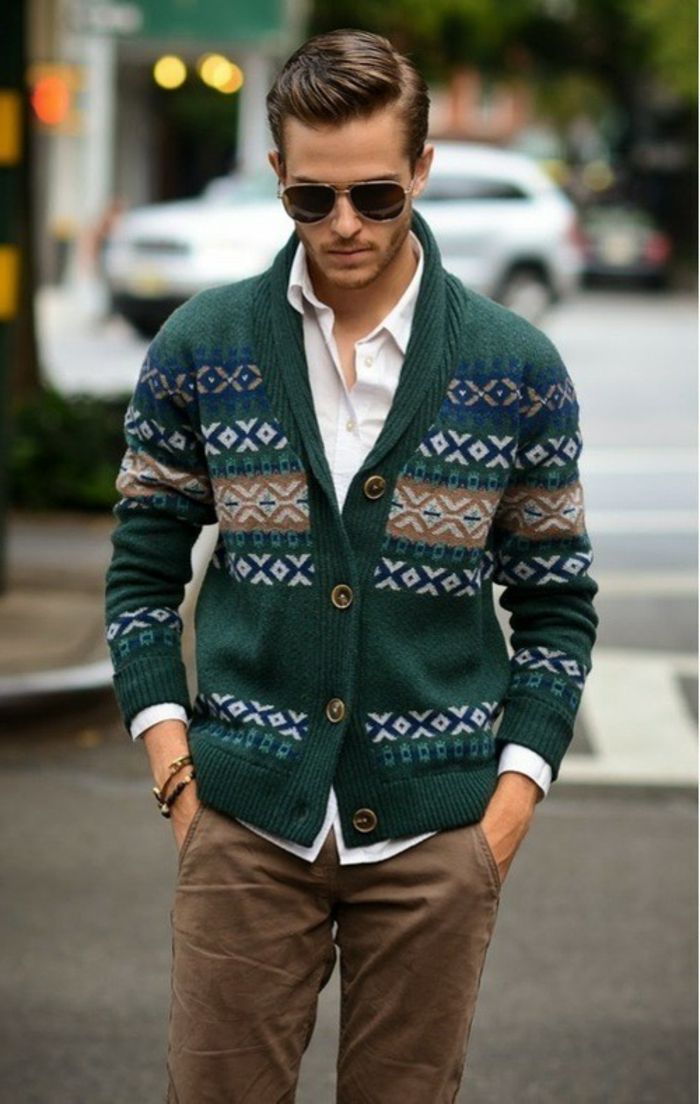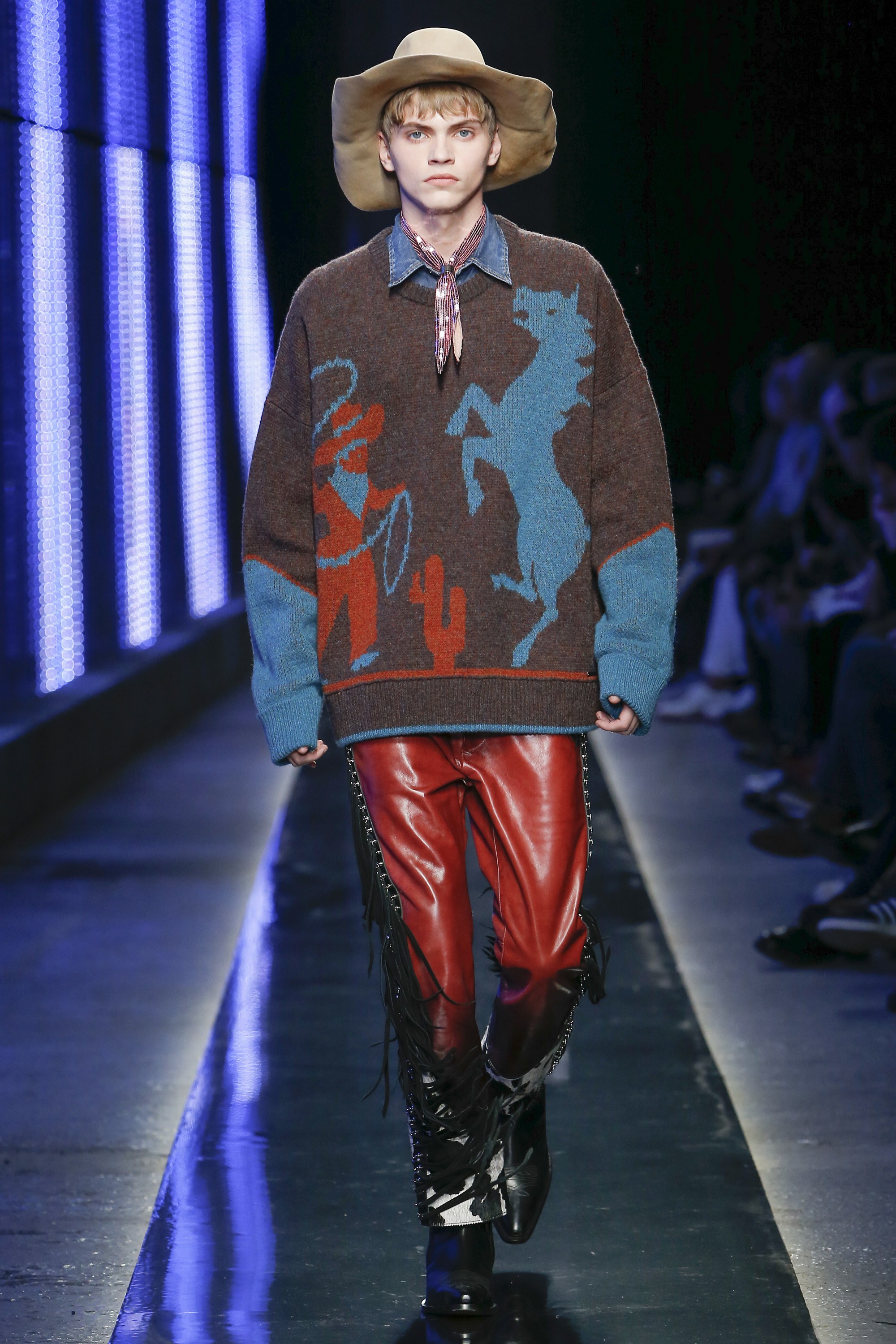J COME JACQUARD
A sinistra, scatto di Federico Miletto per The Men Issue, Styling Giovanni de Ruvo. A destra, scatto di streetstyle (fonte: lookastic.it).
L’alfabeto della Moda oggi chiama in causa la lettera J, per Jacquard.
Probabilmente con un po’ più di fortuna, oggi questa tecnica avrebbe avuto un nome italiano, magari “Il Calabrese”.
Certo, suona strano, ma come tutte le cose, con la forza dell’abitudine, ci sarebbe poi parso come la normalità.
Oggi, sia in Italia che nel resto del mondo, questa tecnica è conosciuta con il nome del suo inventore Francese, Il Signor Joseph Marie Jacquard, forse complice il fatto che, tra il 1804 ed il 1806, le tecniche e le conoscenze nel settore furono forse decisamente più avanzate, rispetto al xv secolo.
Da Italiano sarò di parte, ma è importante spiegare come sono andate le cose, ne consegue quindi una breve spiegazione.
Il primo e vero prototipo del telaio Jacquard fu realizzato nella seconda metà del secolo xv da un tessitore Catanese, conosciuto a Lione come “Jean le Calabrais”, ossia Giovanni il Calabrese, che, ospitato da Luigi XI, introdusse questa nuova tipologia di telaio in grado di lavorare i filati più velocemente ed in modo più preciso; avrebbe portato quindi si una miglioria alla manifattura tessile di Lione, ma allo stesso tempo, forse, ad una maggiore disoccupazione nel settore. Fu fortemente ostacolato quindi dal resto dei tessitori, che non ne favorirono la diffusione.
Anni dopo, il già citato signor Jacquard migliorò la tecnica, riuscendo a creare un sistema in grado di eseguire disegni molto complessi, tramite un telaio ed un macchinario che, con l’ausilio di una scheda perforata, movimentava in maniera automatica i singoli fili di ordito.
Ma torniamo al jacquard in quanto tessuto…
Nella moda, questo tipo di lavorazione ha trovato terreno fertile grazie alle sue molteplici sfaccettature e applicazioni.
Chi ne ha fatto davvero il proprio segno distintivo è Missoni, brand che ha saputo sviluppare in mille varianti, forme e colori questa maglia, adottandola come simbolo e dandole un carattere riconoscibile in tutto il mondo.
Ma da Elsa Schiaparelli con la sua maglieria femminile eccentrica e couture, a Dolce & Gabbana, ad Alexander McQueen che amò fortemente questa tecnica, a Vivienne Westwood fino a Pringle of Scotland, tutti quanti si sono cimentati e si cimentano tutt’ora nell’utilizzo di questa maglia.
Nello scatto realizzato per The Men Issue da Federico Miletto, il modello indossa un cardigan oversize in maglia jaquard in cashmere della collezione fall/winter 18 di Alanui, portato con un look comodo, dall’attitude etnica, cool e un po’ sciancrata.
Nello scatto di streetstyle (da lookastic.it) che troviamo a fianco, il cardigan verde bosco con motivi geometrici, viene portato su una camicia bianca classica ed un chino, con un paio di aviator per un look casual e da città.
Nelle sfilate attuali, i designer, come potete vedere nella gallery che raccoglie alcuni look dalle collezioni del prossimo autunno/inverno, propongono questa lavorazione in svariati modi, dalla vestaglia di Etro super colorata ed etnica, alla maglia di Calvin Klein con ricamo cartoon, fino al cappotto di Alexander McQueen completamente lavorato con jacquard floreale. Giovanni de Ruvo
The Fashion Alphabet today is about J, for Jacquard. Probably with a little luck, today this technique could have an italian name, for example “Il Calabrese”. Today, in Italy as in the rest of the world, this technique is known with the name of its French inventor, Monsieur Joseph Marie Jacquard, maybe with the complicity of the fact that, between 1804 and 1806, the knowledge in that sector was much more advanced than it was in the 15th century. As an italian maybe I might be biased, but it’s important to explain how the facts happened, so here’s a little explanation. The first prototype of the jacquard loom was made in the second half of the 15th century by a weaver from Catania, known in Lyons as “Jean le Calabrais”, that is Giovanni il Calabrese, that, hosted by Louis XI, introduced this new kind of machine able to work the yarns faster and more precisely; it would have brought an improvement to the textile manufacturing in Lyons, but at the same time, maybe, to an increasing unemployment. So he was very obstructed by the other weavers. Years later, the mentioned Monsieur Jacquard improved the technique, creating a system able to make very complex drawings with a loom and an equipment that, using a perforated board, moved automatically the single threads of the warp. But let’s go back to talk about jacquard as a fabric…In fashion it found fertile ground thanks to its various aspects and applications. Missoni made this as its symbol, developing it in thousands of variations, shapes and colors, giving it a recognizable “personality” all over the world. But from Elsa Schiaparelli, with her eccentric and couture women’s knitwear, to Dolce & Gabbana, to Alexander McQueen that loved deeply this kind of knitting, to Vivienne Westwood and Pringle of Scotland, everybody dealt with it and nowadays still deal with it. In the picture by Federico Miletto fot The Men Issue, the model wears an oversize cashmere jacquard cardigan from the Alanui f/w 18 collection, matched with a comfortable look with a touch of ethnic, with a cool attitude. In the streetstyle shot aside (lookastic.it) the green cardigan with geometric pattern is worn on the classic white shirt and a pair of chinos, with aviator sunglasses for a casual, urban look. In the fashion shows, the designers, as you can see in this gallery that collects some looks from next f/w collections, present this kind of knitting in very different ways, from the Etro colored nightgown, to the Calvin Klein sweater with cartoon embroidery, to the Alexander McQueen coat with an all-over flowery pattern. Giovanni de Ruvo








